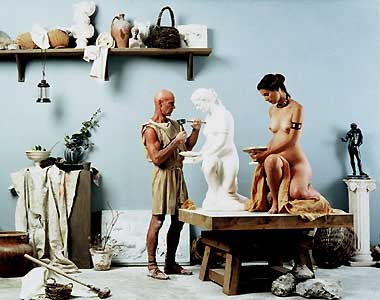|
kunsthallewien.at fig.: Untitled, Fotografie/photography, 2001, aus/from "The Last Days of Pompeii", Eleanor Antin next picture / deutscher text>>> 'Tableaux
Vivants' (Living pictures), re-enacted paintings and sculptures, both
historical and contemporary, have become a staple motif in the daily
flood of pictures: whether it is music videos, commercials, or movies,… Dating back to classical antiquity, they were later integrated, as political and evocative imagery, in the festive pageants of the Renaissance and Baroque periods and, ever since the Middle Ages, in Catholic liturgical processions mainly in Southern Europe and Latin America before they eventually came to serve late 18th century bourgeoisification. In this enlightened era, 'Tableaux Vivants' and their related form, called 'Attitudes', became, as physical representations or re-enactments of artworks and their specific atmosphere, a popular party game in private circles, witnessed, among others, by J. W. Goethe in his 'Elective Affinities' and by Lady Hamilton in the genteel drawing-rooms of Naples. Ever since the 19th they have become a subject for photographers. Members of the bourgeois society and artists had their photos taken in the well-known postures and with the props shown in masterpieces from art history citizens, e.g. by Raphael, Guido Reni, or Nicolas Poussin. In the 20th century, finally, we come across them as an anti-bourgeois, parodistic form in the photographs by Marcel Duchamp, Man Ray or Cindy Sherman, or as powerful visual strategy in the movies of Jean-Luc Godard and Derek Jarman, which finds its continuation in the video works by Bill Viola and Gary Hill. Moreover, the use of 'tableaux vivants' can be observed in the performances of the Fluxus artists, of Marina Abramovic, Valie Export etc. 'Tableaux
Vivants' have an art history of their own, though critical assessment
of this history is only beginning. Obviously, the 'living pictures'
were too marginal as a medium - and evidenced, until the 19th century,
only in literary sources - to come to public awareness as an independent
art form. On the one hand, they had to do with entertainment, with the
fun of dressing up in costume, and with the recognition of great art
by the connoisseur; on the other, they had an influence on the art of
their epoch and, at the same time, depended on it. This exhibition is an attempt, in several sections, to keep track of the history and the transformations of the medium. It starts out with photographic pieces from the 19th century that still tried to translate the painterly element into the aesthetics of photography (Julia Margaret Cameron). The 1920s and '30s (Marcel Duchamp, Man Ray, Karl Valentin) used the 'living pictures' to launch an attack on classical masterpieces. In the 1960s and '70s, they get involved in the conflict of art versus everyday life and are used in the enactment of corporeality (Piero Manzoni, Robert Morris, Timm Ulrichs a.o.), notably so in feminist art (Carolee Schneemann, Valie Export, Hannah Wilke). Since the 1980s, finally, they have, in the wake of postmodern theory and questions of identity, been developed in every possible direction, from criticism to memory work and on to sheer parody, and the number of artists who have taken to work with 'Tableaux Vivants' is now countless. An exhibition
with works of:
|
 TABLEAUX
VIVANTS
TABLEAUX
VIVANTS